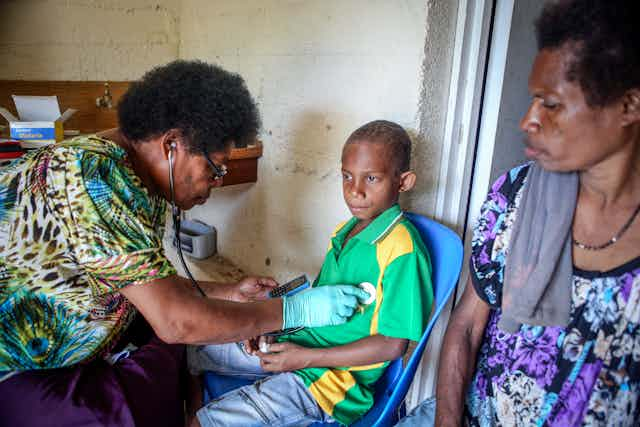A large number of children with malaria in the Asia-Pacific have relapses of the disease, not new infections. These recurrent infections significantly contribute to malaria’s continuing transmission in the region.
Our research, published yesterday in PLoS Medicine, showed 80% of all infections with the Plasmodium vivax parasite in Papua New Guinean children between five and ten were recurrent.
This is because the P. vivax parasite can hide in the liver after the initial blood infection clears. The liver-stage infection can be dormant and undetected for months or even years before it reactivates to continue transmission cycles and cause disease.
Malaria-control programs must target these latent infections to completely eliminate malaria from the Asia-Pacific. Reaching this ambitious goal will be a challenge.
Malaria in the Asia-Pacific
Intensified global control efforts over the past 15 years have significantly reduced the burden of malaria. In PNG, malaria deaths fell from around 20,000 in 2000 to nearly 300 in 2013.

At the 2014 East Asia Summit, member countries formally declared the common goal of a malaria-free Asia-Pacific by 2030. To realise this, the region must get rid of the P.vivax parasite, which is now the predominant cause of malaria transmission outside Africa.
Over a decade ago, P. falciparum was the most prevalent malaria parasite in the region. But control methods have effectively reduced its numbers.
P. vivax liver-stage parasites (and those of the lesser-known P. ovale) are more resistant to existing control efforts and have since overtaken P. falciparum in prevalence.
The P. vivax parasite was also previously considered to be a relatively “benign” form of malaria. But it can in fact cause severe disease and death.
Current treatments
Current treatment methods focus on targeting the blood stage of malaria infection because it comes with clinical symptoms. But it is just as important to treat chronic, liver-borne infections to prevent relapses.

Our recent work in the central province of Solomon Islands showed 13% of people were infected by P. vivax while other forms of malaria have all but disappeared.
We found 85% of these infected people did not feel ill. Because of this, they didn’t seek treatment, without which transmission can continue unabated.
We also know that in PNG, on average, a person with a primary infection can have up to four relapses.
Primaquine is currently the only licensed drug that kills parasites in the liver. But it has to be taken for up to two weeks, posing issues with compliance.
Primaquine also has potentially life-threatening side-effects for a small subset of the population with an inherited enzyme deficiency condition. Few countries have used primaquine in routine treatment as they are reluctant to treat infected patients without testing for the deficiency.
As a consequence, most P. vivax liver-stage infections are not appropriately treated.
Papua New Guinea trial
Our clinical trial looked at children between five and ten in the malaria endemic region of Maprik, PNG.
Children were randomly assigned for treatment with either drugs that only kill blood-stage parasites (artemether-lumefantrine and chloroquine) or drugs that kill both blood and liver-stage parasites (artemether-lumefantrine, chloroquine and primaquine).
Children received these treatments irrespective of whether they had any detectable malaria parasites in their blood. Comparing the risk of infection in children with and without remaining liver-stage parasites allowed us to calculate the proportion of P. vivax and P. ovale infections due to relapses.
Livers of children treated only with blood-stage drugs still contain the dormant liver stages. Those treated with both blood and liver-stage drugs are completely cleared of parasites both in the blood and the liver.
Therefore, any difference in risk of subsequent infections between these two groups of children is due to the dormant liver-stage parasites in the livers of the former.
The trial showed relapses accounted for 80% of all P. vivax infections and contributed as much to maintaining local P. vivax transmission as active infections.
The trial also highlighted that the presence of the active, blood-stage infection is a poor predictor of the risk of relapse.

Mathematical models based on the trial data predicted that mass drug administration (MDA), that includes both blood-stage and liver-stage drug treatments, are the only effective strategy for eliminating malaria in the region.
Mass drug administration
Between the 1960s and 1980s, mass drug administration programs successfully interrupted malaria transmission in Central China, Afghanistan, some former Soviet republics and North Korea.
A similar program had completely eradicated malaria from Tajikistan in the 1960s and then again (after it had resurfaced) in the 1990s.
But such programs are difficult to implement as they involve treating large numbers of uninfected people – as many as 70-90% – with a drug that is potentially harmful and does not have direct benefit. Assuring compliance with a lengthy treatment is one of the biggest hurdles.
Future research efforts must prioritise developing better methods of identifying people chronically infected with malaria. A diagnostic test that can detect dormant P. vivax will be critical for eliminating malaria throughout the Asia-Pacific region.

